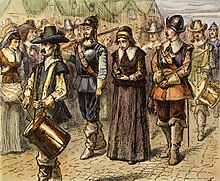Mary Dyer
Mary Barrett Dyer (* around 1611 in London , † June 1, 1660 in Boston ) was a Quaker who was hanged in Boston, Massachusetts , because she had repeatedly entered the city, although the Quakers had been banished from her.
Life
In the early 1630s, Mary and her husband William emigrated to New England to escape the growing pressures placed on Puritans in England . The two lived in Boston from 1635. In 1637, Mary Dyer met Anne Hutchinson , who taught that God spoke directly to everyone, not to the clergy alone . Mary Dyer became a supporter of Hutchinson's and a member of a movement called " Antinomic Heresy ." The group organized Bible readings that developed opposing positions to the religious laws of the Puritans of the Massachusetts Bay Colony .
In 1638 Mary Dyer and her husband William were banished from the colony along with Anne Hutchinson. Based on the recommendation of Roger Williams , the group moved with the Dyers to the Portsmouth colony in Rhode Island . There, William Dyer and 18 other men signed a manifesto known as the Portsmouth Compact .
Mary Dyer and her husband returned to England with Roger Williams and John Clarke in 1652. There, Dyer heard a sermon by the Quaker founder, George Fox, and then converted because she felt close to the ideas she and Anne Hutchinson represented. Eventually she appointed herself a Quaker preacher.
In 1657 the Dyers returned to Rhode Island. A year later, Dyer traveled again to Boston, where a new law banned the Quakers from the colony. She was arrested and banished from the colony. Her husband, who had not converted to the Quakers, was not arrested.
Mary Dyer then traveled to New England to spread the teachings of the Quakers. In 1658 she was arrested in New Haven , Connecticut . After her release, she returned to Massachusetts to visit two Quakers who had been imprisoned there and exiled from the colony for life.
She was arrested again during a third visit to Massachusetts where she and a group of Quakers opposed the law in public. In a brief trial, she was sentenced to death along with two other Quakers . While her fellow prisoners were being hanged , her husband's objection to his friend, the governor of the colony, John Winthrop , could lead to a last-minute pardon - against her will, for she had refused to renounce the teachings of the Quakers.
Dyer was forced to return to the Colony of Rhode Island . From there she traveled to Long Island to spread the teachings of the Quakers there. In 1660 she felt called to travel to Massachusetts one more time to fight the law banning Quakers. Against the requests of her husband and children, she refused to renounce. So she was tried again and sentenced to death on May 31, 1660. The next day she was hanged on Boston Common .
Today a statue in front of the Massachusetts State House in Boston commemorates Mary Dyer.
literature
- Claus Bernet : Mary Dyer. In: Biographisch-Bibliographisches Kirchenlexikon (BBKL). Volume 20, Bautz, Nordhausen 2002, ISBN 3-88309-091-3 , Col. 414-420.
- Victor Grossman : Rebel Girls: Portraits of 34 American Women (= New Small Library , Volume 185), Papyrossa, Cologne 2012, ISBN 978-3-89438-501-9 . Pp. 17-20.
Web links
- Claus Bernet : Quaker of the week (5): Mary Dyer , blog entry from Sunday, January 29, 2012.
| personal data | |
|---|---|
| SURNAME | Dyer, Mary |
| ALTERNATIVE NAMES | Dyer, Mary Barrett (full name) |
| BRIEF DESCRIPTION | American Quaker, last religious martyr in North America |
| DATE OF BIRTH | around 1611 |
| PLACE OF BIRTH | London , UK |
| DATE OF DEATH | June 1, 1660 |
| Place of death | Boston , Massachusetts , United States |
